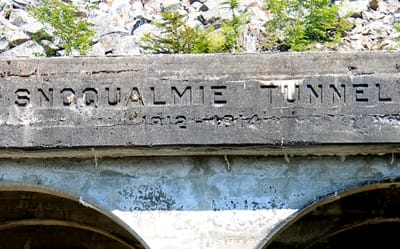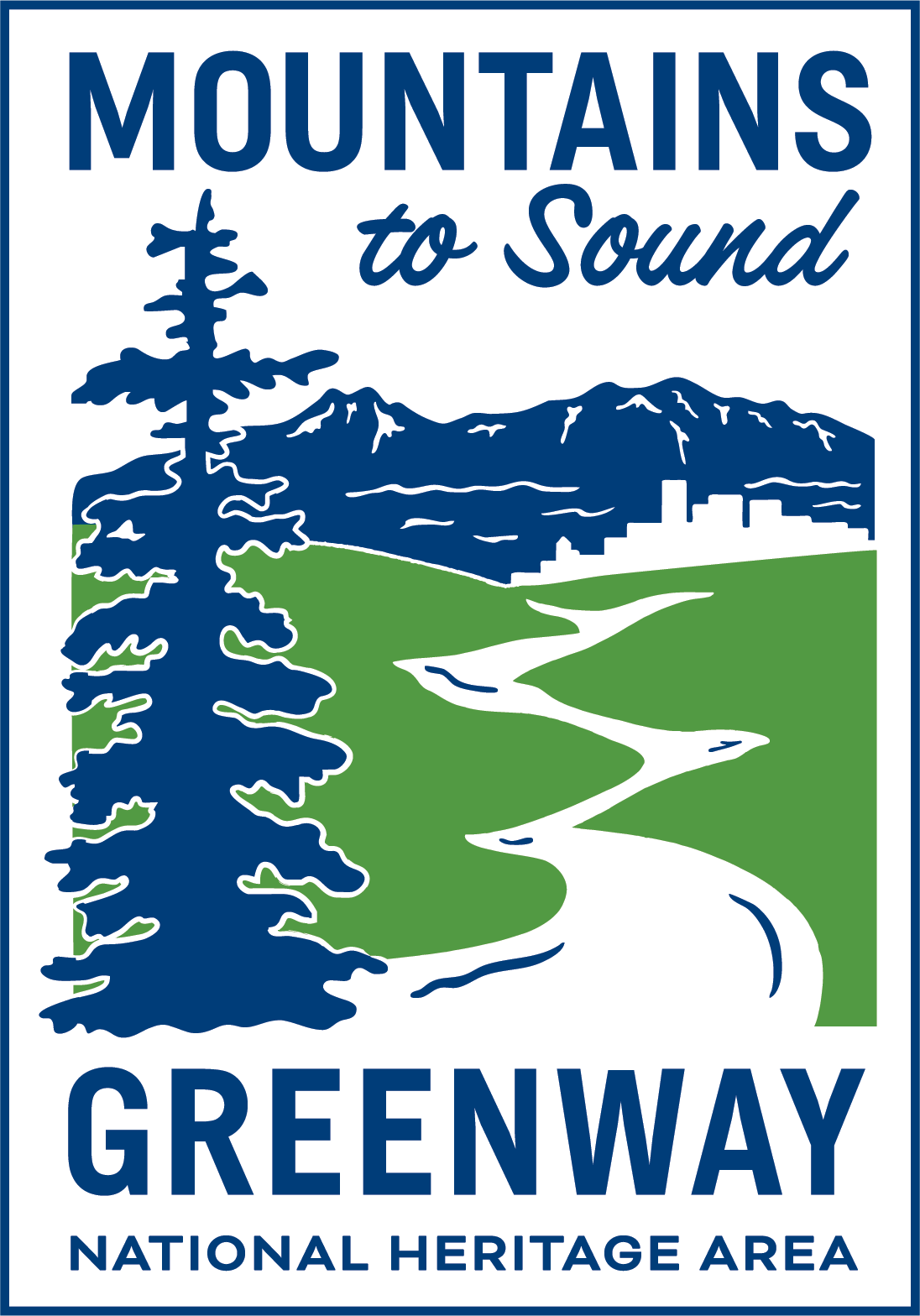Greenway Icon Celebrates its 100th Birthday
By Gene Bisbee, Greenway Guest Blogger
www.bikingbis.com
On an overnight bike-camping trip to the John Wayne Pioneer Trail earlier this summer, I paid particular attention to the inscription above the west portal of the 2.3-mile long Snoqualmie Tunnel:
It reminded me that there’s a centennial anniversary coming up – this month (August) in fact.
The unlit tunnel is the longest on a rail-trail in the US, according to a survey by Rails-to-Trails Conservancy. It’s also the highest point on the trail that runs for 110 miles through Iron Horse State Park from Cedar Falls (near North Bend) to the Columbia River.
The passage is a critical link for hikers and bikers traveling across Washington State.
“The mysterious, dark, 2.3-mile Snoqualmie Tunnel in Iron Horse State Park is a wonderful monument to our region’s railroad history,” says Cynthia Welti, Executive Director of the Mountains to Sound Greenway Trust. “This tunnel was built to protect trains from severe winter weather. Bicyclists, hikers and equestrians now enjoy this former railway corridor as a trail that runs 75 miles through the Mountains to Sound Greenway.”

For many bicyclists and hikers, the straight-as-an-arrow tunnel is the highlight of a visit to the John Wayne Pioneer Trail.But the railroad didn’t build the tunnel for bicyclists. The passage running 1,500 feet beneath the mountains served as a shortcut for trains on the Chicago, Milwaukee, St. Paul and Pacific Railroad (aka The Milwaukee Road) from 1915 to 1980.
The original railroad corridor that opened in 1909 crossed the mountains at a different location, stopping at the long-gone Laconia station. But even then, the railroad’s engineers were surveying a route for a tunnel to serve as a shorter passageway that also was protected from snow.
Joined on Aug. 4
Work actually began on Tunnel No. 50 in 1911, and 700 men were employed in the task. A crew working from the eastern end met the crew boring in from the west on Aug. 4, 1914. It had been hard work, the crews using more than 300 tons of dynamite to blast through 11,888 feet of rock. All the finish work took until Jan. 1, and the first passenger train passed through the tunnel on Jan. 24, 1915.
The railroad spent $2 million to build the tunnel. It cost almost half that (in current dollars) for the state to rehabilitate the structure in 2011. It had been closed for two years (since 2009) when inspectors determined the crumbling ceiling and walls were dangerous to those walking or pedaling through the tunnel. Those loose sections are encased by concrete now.
The Milwaukee Road used the tunnel until the railroad was sold and the route abandoned in 1980. The state acquired the right-of-way a few years later, but couldn’t get the tunnel refurbished for recreational use until 1995.
-

Snoqualmie Tunnel Exit
Personally, I find riding in the tunnel kind of creepy, but that hasn’t stopped me from passing through at least a dozen times. I enjoy the gently uphill (1.7% grade) ride from Cedar Falls and the mostly sunny weather along the crest of the Cascades in the summer. Riding into the tunnel reminds me too much of the cold, wet weather we seem to get nine months a year.And it is very dark inside. Only a pinpoint of light is visible at the end of the tunnel when entering from the east portal at Hyak. Nothing is visible ahead when traveling from the other direction until you’re near the exit. Lights are a necessity.
But the tunnel is a big draw for the trail. There’s no other place where you can pedal for 2.3 miles through a mountain. Former state transportation secretary Douglas MacDonald wrote at Crosscut.com that 250,000 people visited the rail-trail in the 2009 tourist season, and 80 percent of them passed through the tunnel.
From the west, bicycle riders climb about 1,500 feet on a hard-packed gravel trail for 20- miles from the Cedar Falls Trailhead to the west portal of the tunnel. Other visitors simply drive to the Hyak Trailhead and enter through the east portal.
The temperature inside can be cold in the summertime, and there’s often a stiff west-to-east breeze blowing through the tunnel. More than once I’ve emerged from the dampness to witness fog pouring out of the east entrance.
If you haven’t visited the tunnel, the old lady’s 100th birthday would be a good time. Remember, you’ll need a state park Discover Pass to park at the trail heads at Hyak or Cedar Falls.
——————————————————–
Gene Bisbee writes about bicycling and lists recreational and charity bike rides at his blog, www.bikingbis.com, where a version of this article first appeared. He’s also the author of “Best Bike Rides Seattle,” published this summer by FalconGuides and available at Amazon and bookstores.
More Information about the Snoqualmie Tunnel:
Guided Bike Trip through the Tunnel: Explore the Greenway Trips
Mountains to Sound Greenway blog: Legacy of the Milwaukee Road Railway
Crosscut.com: Hiking the long tunnel at Snoqualmie Pass
History of Laconia at Snoqualmie Pass
National Trails Training Partnership: Tunnels on Trails – a study of 78 tunnels on 36 trails






